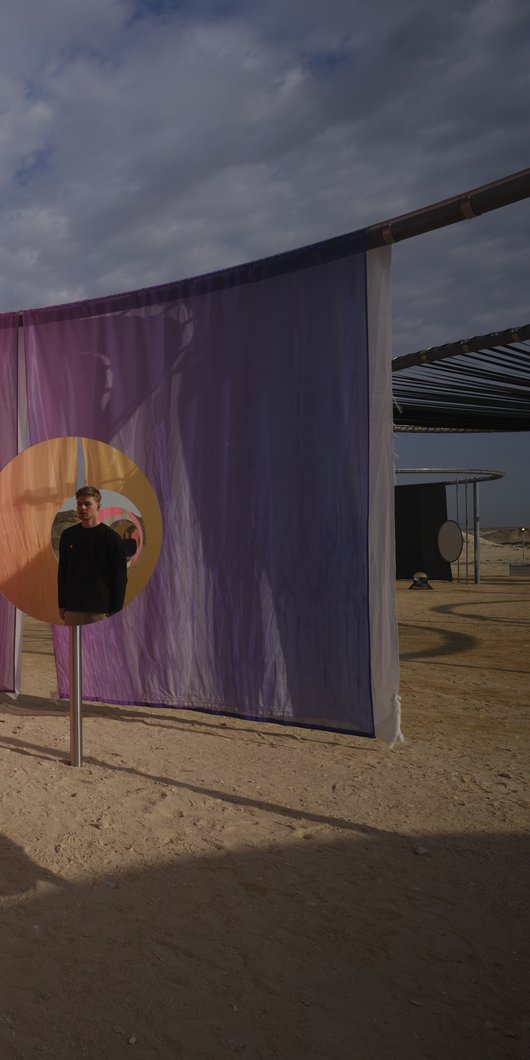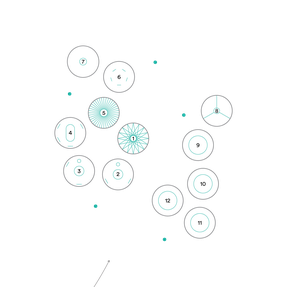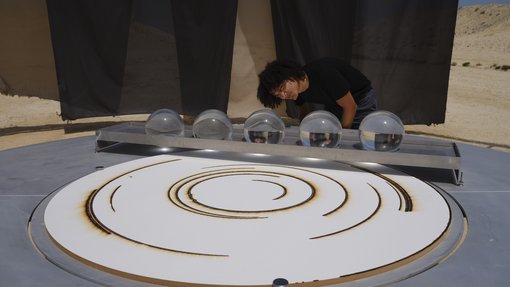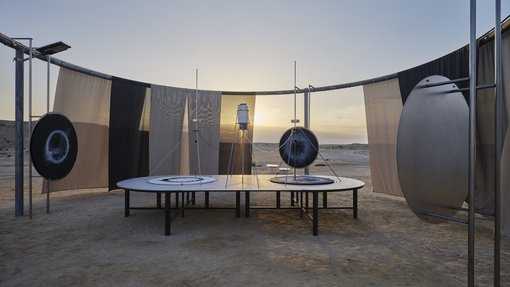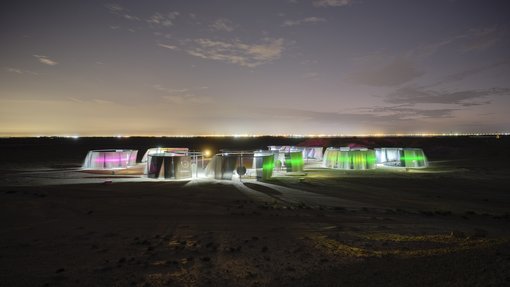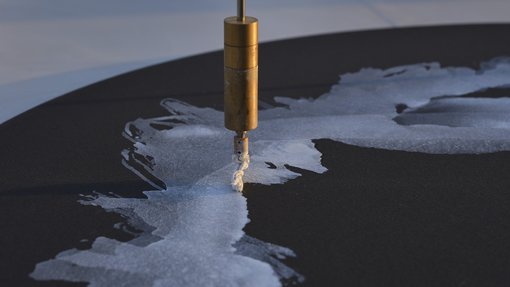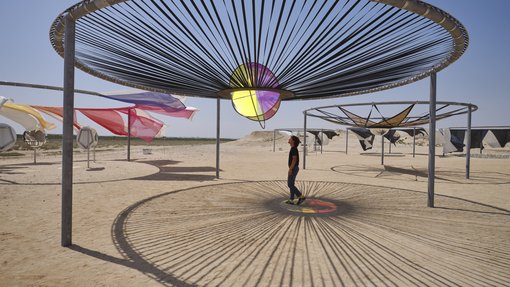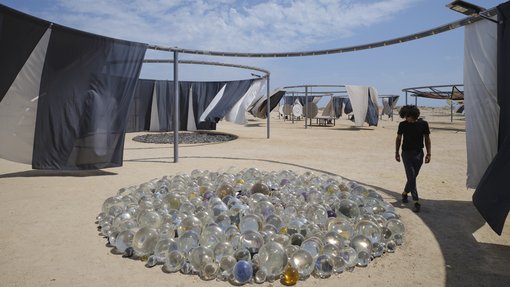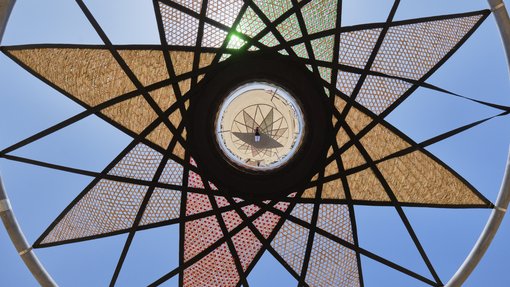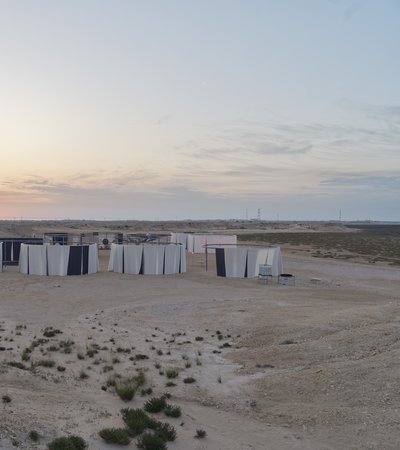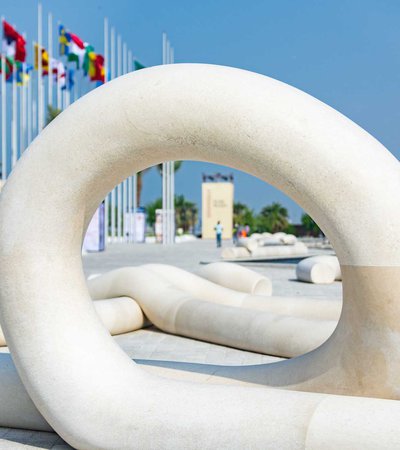- Your sun compass
The top of Your sun compass is hung with triangular wicker panels that form a star with sixteen rays: a compass rose. The densities of the weaves vary according to the directions of the compass rose; east and west are darker than the ordinal directions of northeast, southeast, southwest and northwest. Coloured glass discs are integrated into the rays facing north and south, with green indicating north and red, south.
A parabolic mirror hung at the centre of the compass rose reflects the shadow of the whole construction as it appears on the ground below, together with the visitors and their surroundings, subsuming them into the work.
As the earth moves in relation to the sun, the shadows travel around the space and extend outside the boundaries of the open pavilion.
2. Solar-drawing observatory (Large spheres)
The drawing machine at the centre of this pavilion is powered primarily by the sun and by the movement of the planet. Two rows of glss spheres of various sizes are supported on adjustable racks above a sheet of fireproof paper. The glass spheres act as lenses that focus the sunlight into points of intense light that burn marks onto the paper. As the position of the sun in the sky changes in relation to the glass spheres, the light travels across the paper, marking it over the course of the day. A motor beneath the table slowly rotates the paper, enhancing the motion of the Earth and lengthening the lines on the page. Upon completion, the drawings are removed and displayed, first within the pavilion and later at the National Museum of Qatar.
3. Solar-drawing observatory (Small spheres)
The mechanism of the drawing machine in this pavilion is similar to that in Solar-drawing observatory (Large spheres). Here, however, three different sizes of spheres are positioned in a circular plate that is suspended above the turning paper. The position and sizes of the spheres correspond to certain days of the year and hours of the day, so that the resulting drawings will be different for each day of the year. Here, too, the drawings will be first displayed within the pavilion and then in the gallery at the National Museum of Qatar.
4. Saltwater-drawing observatory
The device on view in this pavilion is a drawing machine, similar to experiments that Eliasson first began developing in the 1990s in collaboration with his father, Elias Hjörleifsson. Two circular canvases – one white and the other black – turn slowly on motors as water, mixed with black and white pigments respectively, drips down onto the spinning surfaces. The wind causes the drawing utensil to move across the urface of the turning page, leaving undulating marks upon the surface. The drawings, portraits of the weather conditions at the location, are periodically removed and displayed, first inside the pavilion and later at the National Museum of Qatar.
5. Slow solar event
The sculptural construction suspended at the centre of the canopy is formed from two perpendicularly intersecting elliptical discs, each glazed with three tones of dichroic, colour-effect filter glass. This material reflects certain wavelengths of light while allowing others to pass through it, so that the glass appears to be a different colour depending on the angle at which the light hits it and the position from which it is seen. Here, the colours of the shadows produced – cyan, magenta and yellow – correspond to the primary colours of the subtractive colour model. When the shadows overlap, the colours mix to produce the secondary tones of red, green and blue. When the sun reaches its highest point, the projection on the ground directly below aligns to form an ellipse divided equally into red and green, with red indicating south and green north. This work reflects Eliasson’s enduring interest in colour theory and light as the basis for aesthetic and spatial perception.
6. Your fivefold vanishing points
Five circular mirrors, positioned at the corners of an invisible pentagon, produce a surprising environment of multilayered, tunnel-like reflected spaces. Eliasson frequently uses mirrors to expand spaces and evoke a subtle sense of disorientation. When viewers stand within the circle of mirrors, they see themselves and the others around them in a strange, subtly new way, recurring again and again from unexpected angles. The different hues of the surrounding curtains range from red, orange to yellow; a part of the spectrum of visible light. The mirrors re-mix the familiar progression, conjuring a series of colourful concentric circles, each with its own sequence of tones.
7. Rainbow incubator
The reflective spherical structure at the centre of this pavilion is in fact an optical device. Eleven prisms, arranged along the top of the sphere according to the path of the sun at Al Thakhira, bend and break the daylight as it enters the sphere. Depending on the day of the year, the weather and the time of day, the arc of light appears in different intensities and at various places within the sphere. On a few days of the year – on the solstices and the equinoxes – the rainbow materialises, for a brief moment when the sun reaches its apex, as a perfect circle.
8. City lab for desalination architecture
The arcs that hang down from the reflective disc at the centre of this pavilion are made of ropes. The ends disappear through the surface of the mirror into a ring-shaped basin on its back.
To create the formations that cling to the ropes, salt water from the nearby lagoon is first reduced through evaporation in a circular vessel located to one side, in order to increase the salinity of the water. The water is then pumped up into the basin above the mirror, where it seeps into the cotton fibres of the ropes and further evaporates, leaving a sculptural crust of salt on the ropes.
The formations are reflected in the mirror’s surface, which completes the curves of the ropes into full rings floating in the virtual space of the mirror. This illusion recurs in The complete sphere lamp series, 2015, one of the indoor works on display at the National Museum of Qatar.
9. Your glacial-dust garden
The circle at the centre of this pavilion is filled with a thick layer of rock dust that was ground into a fine grey powder over centuries through the slow movement of glaciers. This so-called glacial rock flour was taken by Eliasson from Greenland and installed originally in the gardens of Versailles, France, as part of the artist’s exhibition there in 2016. The installation is a result of Eliasson’s ongoing dialogue with geologist Minik Rosing, who is developing plans to export glacial rock flour from Greenland to tropical and subtropical areas, where it could be used to revitalise the depleted soil, as it is a rich source of the mineral nutrients that sustain crops and other plants. Here, it stands in contrast to the arid desert sand around it, its cracked surface belying the fecundity within.
10. Your pearl garden
Fascinated by the myriad distorted and repeated reflections that an accumulation of glass spheres produces, Eliasson has used this material again and again over the last decade. The arrangement, which exhibits no particular geometrical logic, includes a number of coloured spheres interspersed among the clear ones. The coloured spheres are not uniformly covered with paint, but have been adorned with small circles of colour at only one point, which causes them to change in appearance according to the angle at which they are seen.
In this context, Eliasson is especially interested in the glass sphere’s resemblance to pearls, the rare objects of beauty that played an important role in the culture and economy of the nearby lagoon.
11. Your obsidian garden
The black, shiny obsidian featured in this pavilion stands out in stark contrast to the sandy ground, suggesting perhaps that it has erupted from beneath the desert. This pavilion was inspired by Eliasson’s hikes through the obsidian fields of Hrafntinnusker, in the Icelandic highlands. The volcanic glass is commonly found in Iceland and other highly volcanic regions of the world. Volcanoes exist at the threshold between the inside and outside of our planet. The earth below our feet is in constant transformation at a timescale that is mostly imperceptible to us, except for at these occasional sites of rupture.
12. Your oil-spill garden
As in Your glacial-dust garden and Your obsidian garden, this work features a material taken from one context and transported to the current location: tar residue that lay on a beach in Qatar as a result of oil spill, both naturally occurring and human-caused. As in the other works, the tar was brought here and arranged in a circle. These three pavilions can be understood in relation to one another thematically. Each reflects one of the massive forces shaping our planet: volcanism, the retreat of the glaciers and finally the petroleum pollution resulting from human extraction of carbon fuels.
Solar incense burner
On display in the two Solar-drawing observatory pavilions, the Solar incense burner uses the same technique as the drawing machines to concentrate the rays of the sun into a point of intense light. A single glass sphere supported on a stand ignites a selection of scents typical of Qatar and the region – oud, musk, amber, among others. Each odour burns for exactly an hour before the next is ignited by the sun's rays. In this way the incense burner functions as a clock, marking the times of day in a variety of scents.
Orientation lights for rising seas, 2023
Five cylindrical lamps divide the desert landscape into distinct sections of five colours of light. The solar-powered lamps are equipped with special lenses, a design originally developed to increase the amount of light emitted by the lamps used in lighthouses. By capturing and redirecting even oblique rays of light from the sources, the facetted structure focuses and increases the light emitted by the lamp, making it visible over greater distances.
Orientation lights for rising seas is a descendent of Five orientation lights, an artwork from 1999 that was installed in San Gimignano, Italy, where the lights’ colours facilitated orientation in the hilly Tuscan landscape. Here, in Qatar, the lighthouses project the light directionally, so that individual colours are only visible by visitors approaching from one particular direction. In this way, they can be used to navigate the landscape.
Selected Images
